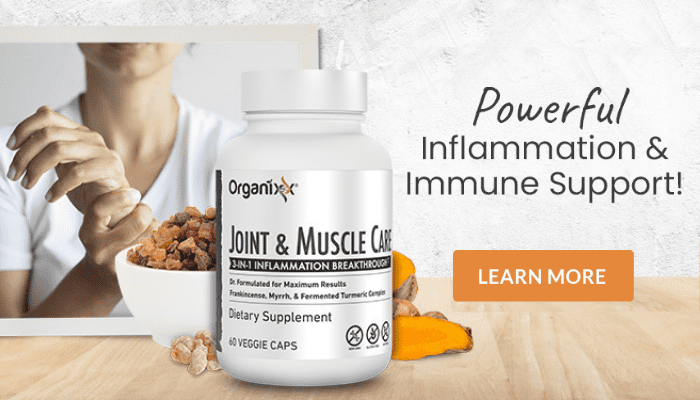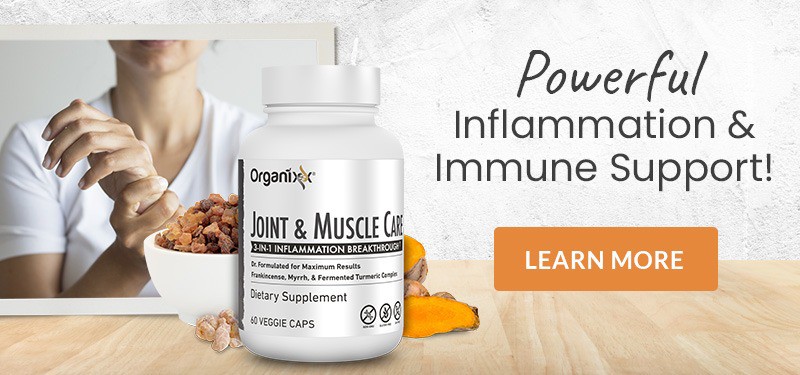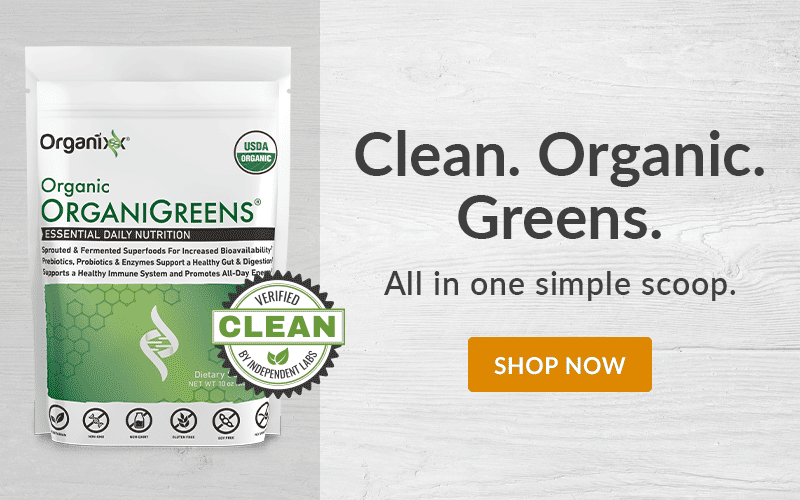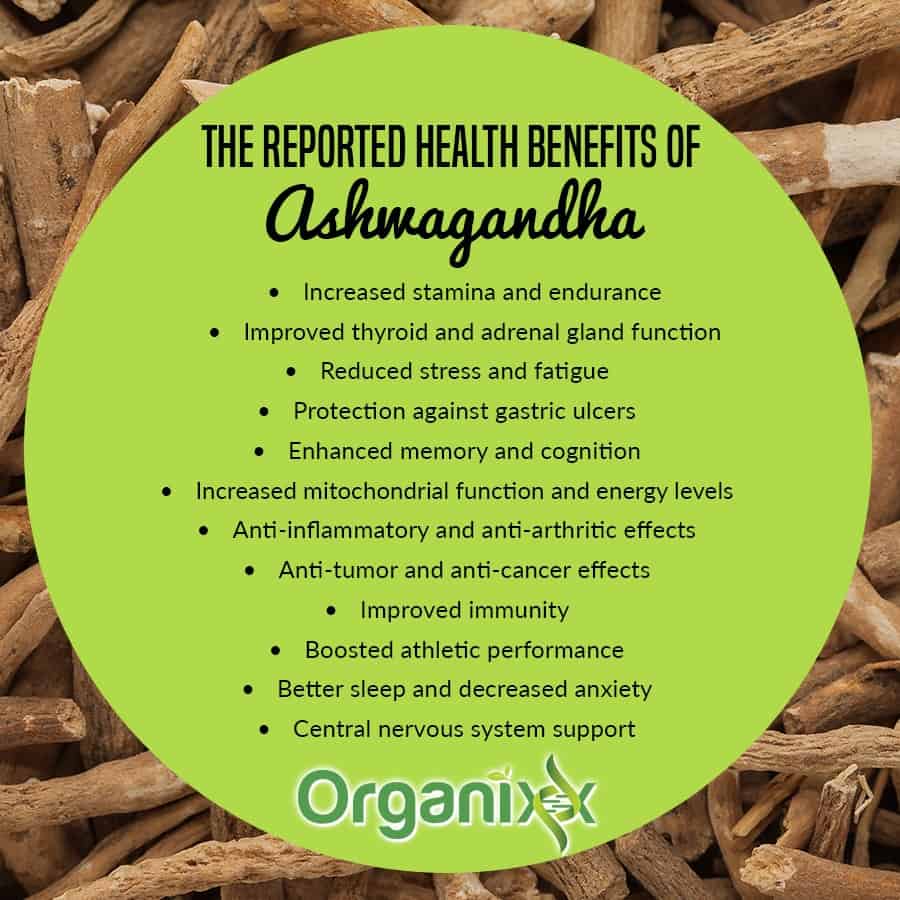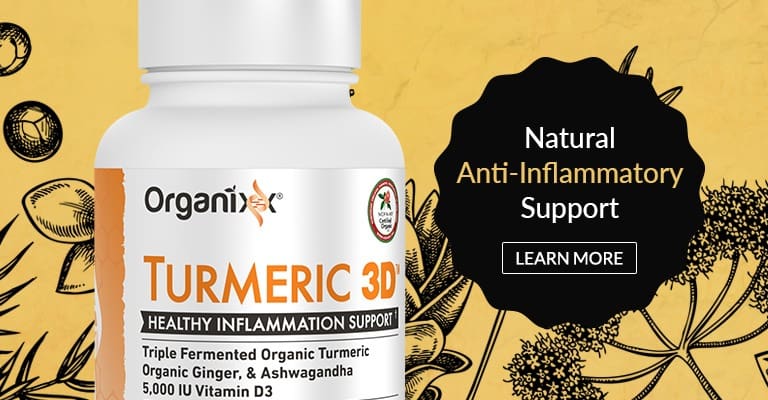Do you want to help your body’s built-in detoxification system? Then, simply put, supporting your liver is a must-do. One well-known natural herb for helping to detoxify the liver is milk thistle (Silybum marianum). Milk thistle is often referred to as the “liver herb” and taking it is a fantastic way to give this vital detoxifying organ (and your whole body) that extra boost. Read on to discover more about how milk thistle benefits your health.
What Is Milk Thistle?
Truth be told, milk thistle isn’t much to look at. You might even mistake it for a weed if you saw it in your backyard, with its thorny leaves and bulbous, purple flowers.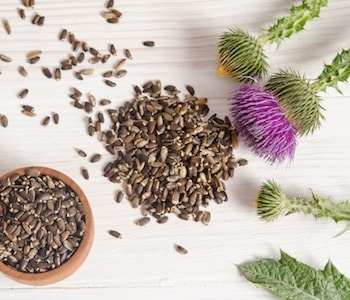 In fact, in many areas outside of its native land (Southern Europe through Asia), it’s considered an invasive weed.
In fact, in many areas outside of its native land (Southern Europe through Asia), it’s considered an invasive weed.
For thousands of years, however, people have used the leaves, seeds, and flowers of Silybum marianum as a liver detoxifier and overall health tonic.
Other names for milk thistle include Mary thistle, blessed thistle, Marian thistle, Mediterranean milk thistle, variegated thistle, Saint Mary’s thistle, and Scotch thistle. (It should not be confused with holy thistle – Cnicus benedictus – which is a different thistle that also boasts many health benefits.)
Whatever it goes by, what makes milk thistle such an amazingly healthy herb are phytonutrients called flavonolignans. In particular, a combination of three flavonolignans which are collectively known as silymarin. They are:
- silybin
- silydianin
- silychristin
Silymarin consists of about 50% silybin, with silydianin and silychristin making up the rest.
The Best Sources of Silymarin
The seeds and flowers of the milk thistle plant are an especially potent source of silymarin, but the leaves can contain it as well. Milk thistle can be found in the whole dried form in herb shops and used as a tea. Increasingly, however, it is powdered and used alone or in conjunction with other liver-supporting herbs in specific formulas.
Supplementing with milk thistle can be a great addition to your everyday routine, especially during times when your liver needs a little more support (like just after the holidays or a vacation where you over-indulged).
Also, as we shall see below, studies have found that those with specific liver problems and conditions such as autoimmune diseases, fatty liver disease, heavy metal toxicities, and even cancer (e.g., breast cancer) can benefit tremendously from adding milk thistle to their existing healing protocol.
Milk Thistle Benefits: 15 Reasons Why Milk Thistle Is So Good for You
Milk thistle can be a great overall tonic for health every day. Apart from a little upset stomach if you take too much, there are no known side effects. Of course, if you have a known allergy to milk thistle, you’ll need to avoid it.
Always remember that plants can be potent, so be sure to seek medical advice from your healthcare provider before taking – especially if you have special health concerns or are on any medication. For example, milk thistle has been reported to counteract some chemotherapy drugs.
#1: Milk thistle detoxifies the liver.
There is a reason why milk thistle is called the “liver herb.” The flavonoid combo of silymarin (and especially the phytonutrient silybin) can help rebuild liver cells while it removes toxins from that organ at the same time.
The liver is central to detoxification in the body, such as storing key hormonal substances, metabolic processes, and cleaning out the blood.
A systematic review of clinical studies of milk thistle requested by the National Center for Complementary Medicine (part of the National Institutes of Health) back in 2000 reported that:
“Evidence exists that milk thistle may be hepatoprotective through a number of mechanisms: antioxidant activity, toxin blockade at the membrane level, enhanced protein synthesis, antifibriotic activity, and possible anti-inflammatory or immunomodulating effects.”
A 2005 report published in Alternative Medicine Review found that the flavonoids in milk thistle act to protect the liver by significantly boosting its resistance to “toxic insult.”
#2: Milk thistle is GREAT for the immune system.
Because it provides such support for the liver, milk thistle also fortifies the immune system and can even help reduce the effects of aging.
This is because milk thistle is also a super antioxidant, removing pollutants, going after pathogens, and preventing free radical damage in the body. The research suggests that milk thistle supplementation can help support the body against some of the most common disease conditions.
#3: Milk thistle can help detoxify heavy metals.
Milk thistle has been shown to help reverse damage to the liver caused by heavy metals such as mercury, arsenic, cadmium, and lead. It can protect against these metals because of the boost it gives to the liver.
Heavy metal toxicity is a serious issue that most people face at some point during their lives, because of pollutants in the air and water, as well as amalgam dental fillings, which can contain up to 50% mercury.
Heavy metal toxicity is a serious issue as it can lead to:
memory loss
mood changes
cognitive decline
depression
neuropathy.
Milk thistle supplementation, as well as healing the gut through probiotics, can aid the body in eliminating these toxins and restoring balance.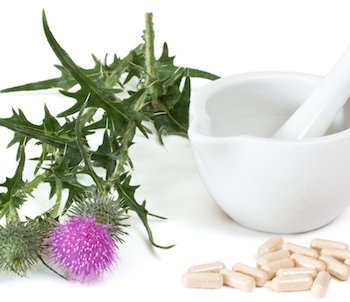
#4: Milk thistle helps prevent abnormal cell growth.
The antioxidant power of silymarin also helps to protect your body from free radical DNA damage that can lead to abnormal cell growth.
#5: Milk thistle boosts glutathione production.
Silymarin can boost the production of the super-antioxidant glutathione, which is found in its most potent form when it is produced inside the body. Glutathione is produced in part within the liver, and milk thistle has been found to strengthen liver cell walls.
#6: Milk thistle can help lower inflammation.
A January 2017 study discovered that milk thistle helped to reduce the “inflammatory cascade” associated with hepatitis C while at the same time modulating the immune system and acting as an anti-viral agent, which can also lead to inflammation reduction system-wide.
#7: Milk thistle can help to lower your risk of obesity.
Obesity is often the result of a vicious cycle of poor lifestyle choices, poor metabolism, poor detoxification, low energy, high toxic load, and inflammation. By supporting detoxification pathways, those who suffer from obesity can receive a helping hand with their weight loss goals.
A 2004 report published in The Journal of Alternative and Complementary Medicine hypothesized that human exposure to chemical toxins can have damaging effects on weight control mechanisms within the body and may even be a major factor in the global obesity epidemic.
Protecting the body from these toxins, which milk thistle does, may result in a normalization of weight regulation functions.
#8: Milk thistle may be beneficial for people with diabetes.
While milk thistle’s benefits to the liver have been known for quite some time, researchers are just beginning to discover its effects for helping to regulate blood sugar levels and insulin resistance, which may benefit those with type 2 diabetes.
A 2007 study conducted by the Universidad de Salamanca in Spain found that milk thistle has “anti-hyperglycemic properties” and may help regulate “liver gluconeogenesis.”
#9: Milk thistle can help with depression.
Liver overload can lead to a neurotoxic buildup in the brain, which can exacerbate and even cause mental imbalances such as depression, anxiety, bipolar disorder, and schizophrenia.
By supporting detoxification in such a major way, milk thistle supplementation can help to turn depressive conditions and other neurological imbalances around.
Sixteenth-century botanist John Gerard declared St. Mary’s thistle (i.e., milk thistle) “the best remedy that grows for all melancholy diseases.”
#10: Milk thistle can make your skin glow.
Studies have shown that milk thistle can help prevent skin damage such as dark spots as well as lines and even wrinkles by protecting from UV light. Again, this is because of its antioxidant properties, which also help protect joint tissue health.
#11: Milk thistle can help you detoxify from too many pharmaceutical pain relievers.
Because of all the support it provides for the liver, milk thistle can assist with detoxing from heavy pharmaceutical use, helping you to avoid the dangerous side effects of long-term use.
A 2010 study conducted by the University Magna Graecia in Spain found that silymarin from milk thistle helps to counter the negative side effects of heavy acetaminophen use.
#12: Milk thistle can help you after too much alcohol consumption.
Several studies have zeroed in on milk thistle’s protective effects against liver disease, especially cirrhosis caused by excessive alcohol consumption.
Many studies suggest that it can even help to reverse the damage caused by alcohol consumption. Just to be clear, however, taking milk thistle is not a replacement for cutting back if you drink in excess on a regular basis.
#13: Milk thistle can help clear out gallstones.
Milk thistle can be a great boost for your gallbladder. The gallbladder is a small, oblong-shaped organ that sits just below the liver and is responsible for the production of bile – a high-alkaline fluid essential for digestion.
Many studies, including a 2011 meta-analysis published in the Journal of Advanced Pharmacy Education & Research, have linked it to a reduction in gallstones.
Studies also suggest that milk thistle can be beneficial for those with cholestasis, a common condition where the gallbladder stops making bile, or bile production is severely limited.
#14: Milk thistle can help turn around fatty liver disease.
It’s good news that the conventional medical community has acknowledged the healing power of milk thistle enough that it has been approved as a “therapeutic treatment” for many kinds of liver disease, including fatty liver.
Fatty liver is caused by a build-up of fat in the liver which causes the liver’s function to wane and can lead to diabetes, cirrhosis, and liver cancer.
While fatty liver disease was once associated only with alcoholics, it’s now of major concern to an increasing number of individuals in industrialized countries. Fatty liver is associated with eating the standard American diet (SAD) and possibly with GMOs as well.
#15: Milk thistle is great for individuals with autoimmune disease.
Many conventional treatments for the dozens of autoimmune conditions that exist today, such as lupus, rheumatoid arthritis, and MS rely on harsh drugs that act to suppress certain mechanisms of the immune system.
Natural substances such as milk thistle help to balance the immune system so that proper communication and function can gently and gradually be restored.
Milk thistle’s liver-boosting properties can also be of great benefit to autoimmune disease sufferers, who often have problems with sluggish detoxification pathways.
Many expert protocols for common autoimmune conditions such as Hashimoto’s thyroiditis and diabetes incorporate milk thistle in some way. If you have an autoimmune condition, be sure to ask your naturopathic physician about how milk thistle can help you.
By now, you should be convinced of not only the amazing milk thistle benefits but also how supporting your liver can help your entire body stay healthy and disease-free. There’s no doubt about what generations of Europeans and others have known for so long: the humble plant known as milk thistle is a true gift from nature!
Milk Thistle is an Ingredient in Organixx Liver & Kidney Detoxx
Milk thistle is the first ingredient in Organixx Liver & Kidney Detoxx, part of the 2-step system in the Organixx Cleanse & Detoxx Kit. It’s one of six powerful botanicals selected for their ability to gently detox your system for robust immune protection all year round.
Organixx Cleanse & Detoxx is a two-step formula that provides a gentle yet powerful full-body detox using organic botanical ingredients. Naturally purge your body of toxins, chemicals, free radicals, heavy metals, waste, as well as bacteria, and pesticides. Easily cleanse your colon, liver, kidneys, lungs, and lymphatic system resulting in increased energy, and better digestion with more nutrient absorption, in addition to improved immunity, mental clarity, and overall health and wellbeing.
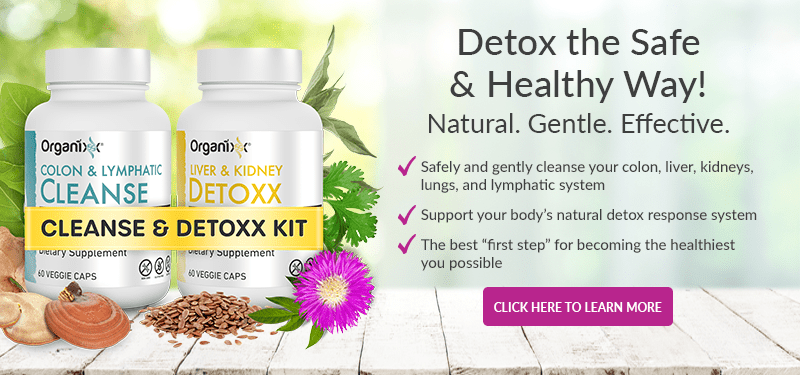
The biblical account of the wise men from the East gifting gold, frankincense, and myrrh to the newborn Christ is a familiar story to Christians all throughout the world. But the consideration of myrrh (Commiphora myrrha) as a precious substance of great worth extends far beyond the Bible and the Middle East.
The various preparations and extracts of myrrh gum (resin) and myrrh oil also have an extensive history of use in traditional healing systems including Ayurveda and traditional Chinese medicine.
Though it’s perhaps most known for its spicy, fragrant odor, which was traditionally used for embalming the dead, myrrh has also long been used as a natural antiseptic for purification in cleaning wounds and preventing infections.
The purifying essence of this resinous sap from the myrrh tree is similarly widely appreciated as having a calming effect when inhaled, lending credence to its widespread use as an incense. In the same vein, myrrh essential oil is considered one of the best essential oils to use for prayer and meditation.
Both empirically throughout the ages and scientifically in modern times, myrrh has proven itself invaluable for a variety of special purposes. And especially in modern times, science has uncovered even more about the unique properties of myrrh that indicate its usefulness in a range of other health applications.
Here are some of the most noteworthy health benefits of myrrh that have been reported in scientific literature. (Note: Always seek medical advice from a qualified healthcare practitioner when addressing specific health issues.)
#1 – Myrrh Contains Anti-Inflammatory Plant Compounds
There are two classes of primary active compounds in myrrh that lend to its efficacy in supporting a healthy immune response: sesquiterpenes and terpenoids.
Both of these compounds are found in a variety of food and plants sources.
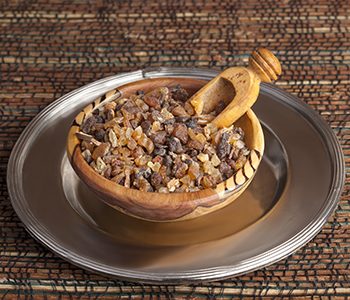 Studies show that sesquiterpenes and terpenoids support the body in soothing inflamed areas, while also protecting against cell damage and the formation of chronic disease [1].
Studies show that sesquiterpenes and terpenoids support the body in soothing inflamed areas, while also protecting against cell damage and the formation of chronic disease [1].
This is particularly true in the intestinal tract, where myrrh has demonstrated benefits in helping to protect the intestinal barrier lining from damage.
Serious gastrointestinal conditions like ulcerative colitis have been shown in the scientific literature to respond positively to the use of myrrh, which appears to exert both protective and healing effects when taken in sufficient quantities.
A 2017 study published in the International Journal of Colorectal Disease, concluded that myrrh was able to aid the body in protecting against three different types of colitis [2]. Another 2016 study revealed specific benefits against acetic acid-induced ulcerative colitis [3].
Some toothpastes and oral care products contain myrrh for much the same purpose, as its extracts have been shown to help protect teeth and gums against the types of inflammation that can lead to things like gum disease, gingivitis, and pyorrhea.
In Germany, myrrh powder is actually government-approved for  treating inflammation of the mouth and throat, the tannins in its resin being recognized as the primary active ingredients in this process [4]. Research conducted by the Dental Research Center at the College of Dentistry at the University of Tennessee also found that myrrh oil is cytotoxic against gingival fibroblasts and epithelial cells [5].
treating inflammation of the mouth and throat, the tannins in its resin being recognized as the primary active ingredients in this process [4]. Research conducted by the Dental Research Center at the College of Dentistry at the University of Tennessee also found that myrrh oil is cytotoxic against gingival fibroblasts and epithelial cells [5].
Many of these same benefits occur when myrrh is applied to inflamed skin, helping to soothe and relieve swelling while promoting elasticity and healthy aging. Applying a small amount of myrrh topically (or adding to skin care products) may also support the body in healing skin infections and promote faster healing from wounds and sores. Be sure to dilute heavily with a soothing carrier oil if you have sensitive skin.
#2 – Myrrh Has High Antioxidant Potential
Besides addressing disease-causing inflammation, myrrh also appears to support the body in reducing disease-causing oxidative stress. One study published in the journal Food and Chemistry Toxicology, for example, found that the antioxidant potential of myrrh is so high that it may support healthy liver function [6].
With an Oxygen Radical Absorbance Capacity (ORAC) value of 379,800 µTE/100g (to put this into perspective, oranges have an ORAC value of 750), myrrh has the potential to help in many other areas as well [7].
In a study on diabetic rats, extract of Mukul myrrh (C. mukul) from India was found to have a beneficial effect on both oxidative stress marker enzymes and hepatic marker enzymes. In their report, the researchers concluded:
“our data indicate the preventive role of C. mukul against STZ-induced diabetic oxidative stress; hence this plant could be used as an adjuvant therapy for the prevention and/or management of diabetes and aggravated antioxidant status [8].”
 In a 2017 study published in the Journal of Evidence-Based Complementary & Alternative Medicine [9], researchers gave women with hyperlipidemic type 2 diabetes either an herbal combination capsule which included myrrh and myrrh resin as two of the three ingredients, or a placebo.
In a 2017 study published in the Journal of Evidence-Based Complementary & Alternative Medicine [9], researchers gave women with hyperlipidemic type 2 diabetes either an herbal combination capsule which included myrrh and myrrh resin as two of the three ingredients, or a placebo.
In the women receiving the herbal capsule “the fasting blood glucose, total cholesterol, and low-density lipoprotein cholesterol levels were decreased and hidh-density lipoprotein cholesterol levels was increased significantly.” The researchers concluded that:
“the herbal combination improves glycemic control and lipid profile in women with hyperlipidemic type 2 diabetes without any adverse events.”
#3 – Myrrh Fights Bacteria, Parasites, Viruses & Fungi
Whether inside the body or on the skin, infection-causing pathogens are another target for myrrh. Studies reveal myrrh’s immune-boosting potential may be effective at supporting the body against conditions ranging from acne, sore throats, and the common cold, to more serious health conditions like pneumonia and even Candida albicans.
In general, myrrh protects against:
- putrefaction
- toxicity
- various other factors that contribute to infections
This, again, being why it was used historically in the preparation of the deceased. It also supports the healthy repair of cellular tissue throughout the body.
Schistosomiasis is a parasitic infection of a type of blood fluke that is  common throughout Asia, Africa, and tropical America. Treatment of schistosomiasis is chemotherapy with the drug praziquantel. But due to drug resistance, researchers tested myrrh on 204 patients with schistosomiasis to determine if it was effective at ridding the body of two different types of parasites: S. haematobium and S. mansoni.
common throughout Asia, Africa, and tropical America. Treatment of schistosomiasis is chemotherapy with the drug praziquantel. But due to drug resistance, researchers tested myrrh on 204 patients with schistosomiasis to determine if it was effective at ridding the body of two different types of parasites: S. haematobium and S. mansoni.
The researchers reported in The American Journal of Tropical Medicine and Hygiene that:
“The drug [myrrh] was given at a dose of 10 mg/kg of body weight/day for three days, and induced a cure rate of 91.7%. Re-treatment of cases who did not respond with a dose of 10 mg/kg of body weight/day for six days gave a cure rate of 76.5%, increasing the overall cure rate to 98.09%. The drug was well tolerated, and side effects were mild and transient. Twenty cases provided biopsy specimens six months after treatment and none of them showed living ova [10].”
#4 – Myrrh Contributes to Healthy, Happy Hormones
 The constituent counterpart to terpenoids in myrrh, sesquiterpenes, serve their own unique role in helping to balance the glandular system, including the hypothalamus, which is recognized as the emotional center of the human body. It is here that the endocrine system connects to the nervous system, regulating both the release and inhibition of hormone production all throughout the body.
The constituent counterpart to terpenoids in myrrh, sesquiterpenes, serve their own unique role in helping to balance the glandular system, including the hypothalamus, which is recognized as the emotional center of the human body. It is here that the endocrine system connects to the nervous system, regulating both the release and inhibition of hormone production all throughout the body.
According to Robert M. Sargis, MD, the main purpose of the hypothalamus is to maintain homeostasis, or internal balance, within the human frame. Its primary functions include the regulation of nearly every component system of the body, including heart rate and blood pressure, body temperature, fluid and electrolyte balance, appetite and body weight, glandular secretions in the stomach and intestines, the production of various substances necessary for the pituitary gland to release hormones, as well as sleep cycles [11].
Does Myrrh Possess Anti-Cancer Properties?
In addition to its ability to support the body in countering oxidative stress and inflammation, there are numerous published and ongoing studies examining myrrh’s relationship to cancer. Studies suggest that it inhibits angiogenesis, a process by which new blood vessels develop to supply “food” to cancer tumors.
For example, in a rat study published in the journal Chemico-Biological Interactions in 2017, myrrh extract was reported to have helped to improve liver function marker enzymes and prevent cancer cell proliferation. The researchers stated:
“these results provide evidence that C. molmol resin [myrrh] has a potent chemopreventive activity, possibly by up-regulating the Nrf2/HO-1 signaling and attenuation of inflammation, angiogenesis and oxidative stress [12].”
In a 2011 study published in the Journal of Medicinal Plants Research, 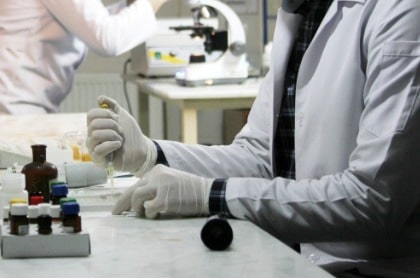 Chinese researchers looked at the effect of myrrh on human gynecologic cancer cells. They concluded that “extracts and compounds from myrrh could be useful for preventing and treating human gynecologic cancer disease [13].”
Chinese researchers looked at the effect of myrrh on human gynecologic cancer cells. They concluded that “extracts and compounds from myrrh could be useful for preventing and treating human gynecologic cancer disease [13].”
None of this should be taken to mean that myrrh in any way prevents or cures cancer and you should always seek medical advice from a qualified healthcare provider. However, in addition to other healthful practices (i.e., good nutrition, sleep, movement, and stress reduction), research appears to show that myrrh can help to support a healthy immune system that is better able to ward off disease.
Cautions When Using Myrrh or Myrrh Essential Oil
Women who are pregnant or breastfeeding should avoid any internal use of myrrh. As noted above in benefit #2, myrrh may lower blood sugar. Therefore, anyone taking diabetes medication who is considering taking myrrh needs to work with their doctor to ensure blood sugar levels do not drop too low.
Of great importance, as well, is the quality of the myrrh oil used for therapeutic effect. Avoid essential oils that have been extracted using caustic chemicals such as hexane in preference for methods such as steam distillation.
When purchasing myrrh oil or products containing myrrh, only purchase quality products from reputable companies that you trust.
Joint & Muscle Care is a revolutionary supplement that takes three of the strongest inflammation support agents in nature (frankincense, myrrh, and turmeric), and combines them in the same perfect union treasured by the ancients. Available in capsule form or as an essential oil blend called Magi-Complexx.
“There was a table set out under a tree in front of the house, and the March Hare and the Hatter were having tea at it…. Oh, surely, surely there were watercress sandwiches! What’s a tea without them?”
~ Alice in Wonderland, Lewis Caroll
Once upon a time, watercress was more than just that green garnish left on the side of your plate. Indeed, watercress was a much loved cruciferous consumed by many, as far back as Roman times. Even old Hippocrates is said to have given his patients watercress [1]. And, as evidenced by the above quote from Alice in Wonderland, a watercress sandwich used to be a delight and necessity for any proper English afternoon tea.
Perhaps it is because it is so easy and fast to grow this water-cultivated vegetable that watercress became known as a “poor man’s food” and went out of fashion. Whatever the reason, it is a shame that this nutrient packed food was relegated to mere decoration.
Happily, more and more people are discovering that watercress is one of the best-kept secrets of the “superfoods” revolution and offers a host of health benefits.
Watercress Gets Top Marks as a Superfood
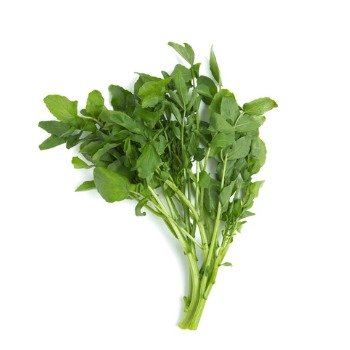 While you’ll often hear the term “superfood” bandied about everywhere these days, in this case it’s true – watercress is absolutely brimming with nutrients and phytochemicals.
While you’ll often hear the term “superfood” bandied about everywhere these days, in this case it’s true – watercress is absolutely brimming with nutrients and phytochemicals.
Perhaps you’ve heard of the ANDI Food Scores? It stands for the Aggregate Nutrient Density Index.
This index evaluates the number and measure of nutrients in a food – minerals, vitamins, carbohydrates, proteins and fats – relative to the amount of calories it contains. The Index gives foods a score out of a possible 1000. The higher the number, the more nutritious the food is considered to be.
Then there’s the CDC’s (Center for Disease Control) Nutrient Density list. This system scores foods out of a possible 100, with top marks given to those “most strongly associated with reduced chronic disease risk [2].”
Watercress gets top marks on both lists, being the only vegetable on the CDC’s list to get a full 100 points [2], while also appearing at the very top of the ANDI, being only one of four items to score a full 1000 [3].
Just to give you an idea of the nutritional benefits of this member of the brassica family, watercress contains more calcium than a glass of milk, more vitamin C than you’ll find in an orange, and more iron than spinach [4,5].
Not only that, watercress is considered a superior organic source of vitamins A, B1, B6, C, of beta-carotene, magnesium, lutein, and zeaxanthin [6].
Especially of note, watercress is one of the only vegetables that contain high quantities of vitamin K. Just one cup of these greens will give you more than the minimum daily recommended amount of vitamin K [4,7].
In fact, watercress contains more than 15 essential vitamins and minerals [5], and all the powerhouse benefits of cruciferous veggies, including the two glucosinolates, sulforaphane and gluconasturtiin (a precursor to the ITC phenethyl isothiocyanate [aka PEITC]) [8].
Bioactive Compounds of Watercress Benefit Your Health
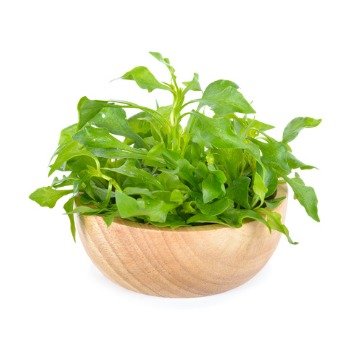 Of all the many nutrients and bioactive compounds found in watercress, the following are of special note when it comes to supporting good health:
Of all the many nutrients and bioactive compounds found in watercress, the following are of special note when it comes to supporting good health:
Glucosinolates:
When looking at the individual phytochemicals of watercress, it makes sense to start with the superfood phenomenon – glucosinolates.
Watercress contains a whopping 32 grams of glucosinolates, per cup [4]. That matters because there are two glucosinolates that have garnered extra attention in the world of health research due to their compounding effects on wellness: sulforaphane and gluconasturtiin.
- Gluconasturtiin: This phytochemical is a precursor to the ITC phenethyl isothiocyanate (PEITC), and watercress contains more of it than any other brassica (cruciferous) vegetable. This is important because it’s a compound that is being studied extensively by researchers for its potential effects on human health [9-11].
- Sulforaphane: This phytochemical is formed when damage occurs to the plant, usually by chewing. Sulforaphane is under even closer scrutiny for its wide range of promising effects on health.
Lutein and Zeaxanthin:
Watercress is a good source of lutein and zeaxanthin. According to the American Optometric Association, deficiencies in these carotenoids have been linked to AMD (advanced age-related macular degeneration) which is the primary cause of blindness for those aged 55 and up [12].
Chlorophyll:
Chlorophyll, as you may recall from biology class, is what makes plants green, and helps them convert sunlight to food. For humans, consuming plants dense with chlorophyll is widely accepted as providing an array of health-promoting benefits.
Vitamin C:
Vitamin C is an important antioxidant that your body requires for tissue repair (including brain repair), making collagen (important for the skin, tendons, cartilage, etc.), as well as both maintaining and repairing bones and teeth.
According to the University of Maryland Medical Center, deficiencies in vitamin C are associated with a number of health ailments, including “high blood pressure, gallbladder disease, stroke, some cancers, and atherosclerosis, the buildup of plaque in blood vessels that can lead to heart attack and stroke [13].”
Vitamin C is a water-soluble vitamin that is excreted through urine. This means your body does not store it, and you need a regular supply.
Watercress is high in bioavailable vitamin C, ensuring you get slightly under 50% of the recommended daily amount in just two cups of the superfood.
The National Health Institute (NHI) has this to say on its vitamin C fact sheet [14]:
“Vitamin C is required for the biosynthesis of collagen, L-carnitine, and certain neurotransmitters; vitamin C is also involved in protein metabolism. Collagen is an essential component of connective tissue, which plays a vital role in wound healing. Vitamin C is also an important physiological antioxidant and has been shown to regenerate other antioxidants within the body, including alpha-tocopherol (vitamin E).
Ongoing research is examining whether vitamin C, by limiting the damaging effects of free radicals through its antioxidant activity, might help prevent or delay the development of certain cancers, cardiovascular disease, and other diseases in which oxidative stress plays a causal role.
In addition to its biosynthetic and antioxidant functions, vitamin C plays an important role in immune function and improves the absorption of nonheme iron, the form of iron present in plant-based foods. Insufficient vitamin C intake causes scurvy, which is characterized by fatigue or lassitude, widespread connective tissue weakness, and capillary fragility.”
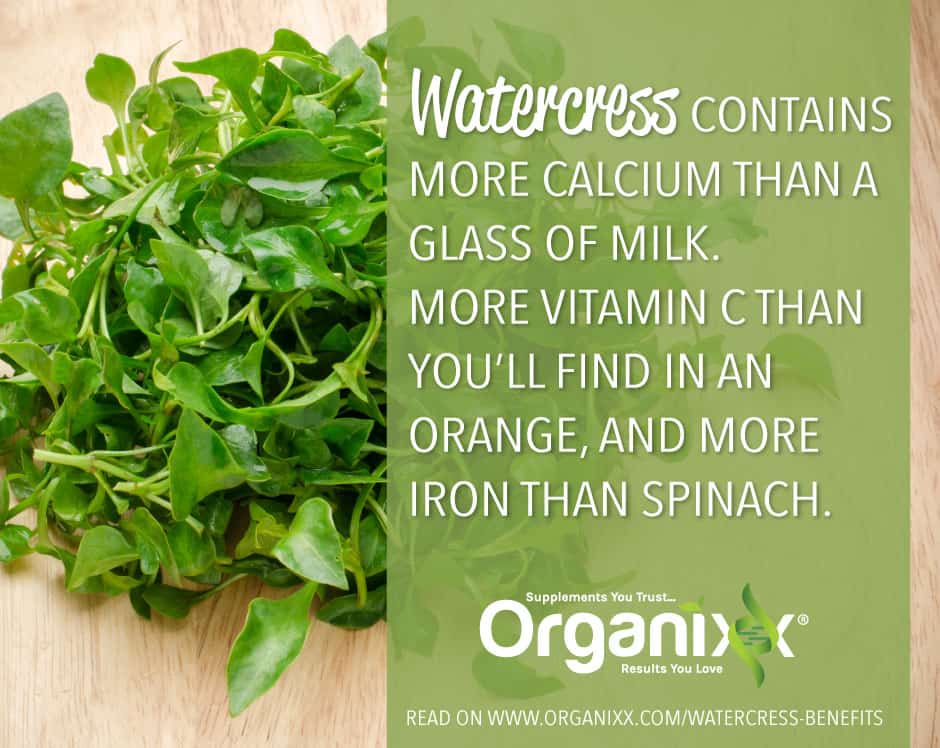
Folate:
Watercress contains natural, bioavailable amounts of this B vitamin (known as folic acid in its synthetic form). Another water-soluble vitamin, your body requires regular doses in order to be healthy. Folate assists cellular function and is a well-known nutrient needed in pregnancy [15].
Calcium:
Getting your required calcium from plant sources has many benefits [16,17]. Not only is calcium required for bone health but also, per the National Health Institute’s fact sheet, for: “vascular contraction and vasodilation, muscle function, nerve transmission, intracellular signaling, and hormonal secretion.”
The NHI also has this to say about deficiency (hypocalcemia):
“Symptoms of hypocalcemia [calcium deficiency] include numbness and tingling in the fingers, muscle cramps, convulsions, lethargy, poor appetite, and abnormal heart rhythms.
If left untreated, calcium deficiency leads to death. Over the long term, inadequate calcium intake causes osteopenia which if untreated can lead to osteoporosis [17].”
Vitamin K:
As previously mentioned, watercress contains high amounts of bioavailable vitamin K, which is a rarity in the plant world. This water-soluble vitamin is named after the first recognized biological role it plays in your body – clot formation (the “K” coming from the German word, koagulation) [19].
Getting the Benefits of Watercress from Your Diet
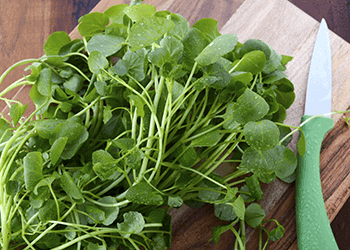 Eating a balanced diet includes consuming an array of fresh fruits and vegetables in order to receive the maximum vitamins and nutrients available from the plant world.
Eating a balanced diet includes consuming an array of fresh fruits and vegetables in order to receive the maximum vitamins and nutrients available from the plant world.
In the case of how to get more watercress in your life: Add a cup to your salad or smoothie. Add it to your soup just as you serve it, so it doesn’t lose all its nutritional value with cooking. Perhaps take a leaf out of Alice in Wonderland and have a watercress sandwich.
In off-season times, or even just for convenience and ensuring you’re getting the full impact of all the best properties of this superfood plant, you may consider a supplement version of watercress.
When choosing a product, keep an eye out for quality and the widest range of absorbable nutrients for optimal health-supporting benefits.
The latest formula of Organic OrganiGreens is our best yet. In just one simple scoop, add 17 sprouted and fermented superfoods and botanicals, plus probiotics and enzymes, to your daily diet to fill nutritional gaps and support healthy immune function, increased energy and mental clarity, as well as digestion and detoxification processes. Easily mixes in water, smoothies, juices, and recipes, and it also tastes great – even without any added sugars.
Ashwagandha (Withania somnifera also known as Indian Ginseng) is a powerful herb that has been used for hundreds of years to treat a wide variety of conditions in the traditional form of Indian medicine known as Ayurveda. Ayurveda – literal meaning, the science of life (“Ayur” = life, “veda” = science) – is a highly evolved medical science that was developed in ancient India centuries ago.
The health benefits of Ashwagandha include its well-known ability to enhance stamina and its truly extraordinary stress-relieving properties.
In Sanskrit ashwagandha means “smell of a horse.” That’s because this herb is said to impart the vigor and strength of a stallion, and has traditionally been prescribed to help people strengthen their immune system after an illness.
Although ashwagandha is frequently referred to as “Indian ginseng” because of its restorative properties, traditional Chinese and Korean ginseng and ashwagandha are not related botanically.
Beneficial Compounds Found in Ashwagandha
Ashwagandha extracts have been shown to contain many beneficial compounds, including withanolides, alkaloids, choline, fatty acids, amino acids, and sugars. While its leaves and fruit do contribute to ashwagandha’s health benefits, extracts of its tuberous roots are most commonly used in herbal remedies.
As many as 200 studies have been carried out on ashwagandha. Let’s take a closer look at some of the scientific evidence for this superstar medicinal herb.
#1 – Ashwagandha Is an Adaptogen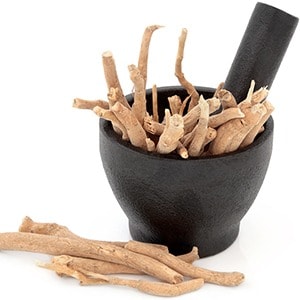
Ashwagandha primarily acts as an “adaptogen.” Adaptogens are substances that stabilize and balance various physiological processes within the body, especially in response to stress and a changing environment.
For example, ashwagandha is known to reduce overall cellular sensitivity to stress. Chronic stress is an ever-present facet of our modern lives and has been linked to a higher risk for a number of illnesses.
In a 2016 study, a double-blind, randomized clinical trial was carried out on 52 people who were subjected to chronic stress and who received either 300 milligrams (mg) of ashwagandha or a placebo control twice daily.
Treatment with ashwagandha significantly reduced stress levels felt by the study subjects, as assessed by various questionnaires. At the same time, blood cortisol levels (a reliable indicator of stress levels), body weight, and body mass index (BMI) were noticeably better in the ashwagandha treatment group when compared to controls.
Similarly, 60 days of treatment with ashwagandha significantly reduced both stress and cortisol levels in 64 subjects in another double-blind, randomized, placebo-controlled clinical trial.
These studies and others indicate that ashwagandha can help to effectively and safely manage chronic stress and its consequences. Along with alleviating stress symptoms, it is also known to combat fatigue, infuse energy, and enhance powers of concentration.
Overall, ashwagandha confers a sense of rejuvenation and wellbeing.
#2 – Ashwagandha Helps Boosts Thyroid Function
Ashwagandha may be able to benefit people with low thyroid function, since animal studies show that it has a thyroid hormone balancing effect.
For instance, when ashwagandha root extract was given daily to adult mice for 20 days, researchers found that their blood levels of both thyroxine and tri-iodothyronine (T3) were increased.
Thyroxine is the hormone secreted by the thyroid gland into the blood, from where it travels to organs like the liver and kidneys and gets converted to its active form, tri-iodothyronine or T3.
T3 affects almost every physiological process in the body, from growth and development to metabolism, body temperature, and heart rate.
Similarly, in a randomized clinical trial, 8 weeks of treatment with ashwagandha was seen to increase levels of thyroxine in patients with bipolar disorder.
In other words, ashwagandha appears to help correct hypothyroidism by helping to balance the level of thyroid hormones.
#3 – Ashwagandha Helps to Manage Blood Sugar and Insulin Levels
 In a 2015 laboratory study, rats given fructose for 8 weeks showed significant increases in their blood sugar and insulin levels, along with higher insulin resistance.
In a 2015 laboratory study, rats given fructose for 8 weeks showed significant increases in their blood sugar and insulin levels, along with higher insulin resistance.
However, rats treated with ashwagandha root extract along with fructose did not show these changes. In other words, in this study the onset of diabetes-like symptoms was stopped in its tracks by ashwagandha treatment.
Separately, ashwagandha has been shown to raise the levels of the liver enzyme glucose 6-phosphatase, which is known to play a key role in controlling blood sugar levels.
#4 – Ashwagandha Neutralizes Harmful Free Radicals
In the thyroid study described earlier in which ashwagandha root extract was given daily to adult mice for 20 days, lipid peroxidation in the livers of these mice was found to be reduced as well.
Lipid peroxidation is the process by which harmful free radicals steal electrons from lipids that make up protective membranes in our body’s cells, damaging them and the cells they are meant to protect. In other words, treatment with ashwagandha root extract significantly reduced the extent of free radical-induced damage in the liver.
At the same time, it also enhanced the activity of other antioxidant enzymes that are found naturally in the liver, including superoxide dismutase (SOD) and catalase, thereby boosting overall antioxidant activity.
Similarly, treatment with an extract of ashwagandha was seen to reduce levels of malondialdehyde – an indicator of oxidative stress – while also boosting total antioxidant capacity in mice.
#5 – Ashwagandha Helps Boost the Immune System
Laboratory evidence in mice suggests that ashwagandha can dramatically increase numbers of white blood cells, thereby boosting immune system activity.
Indeed, studies have shown that ashwagandha can help prevent the immune system from becoming suppressed during chemotherapy.
Normally lower white blood cell counts occurring as a result of chemotherapy places patients at a higher risk of infections, but this risk may be reduced by ashwagandha therapy.
#6 – Ashwagandha Aids With Joint Pain
A 1991 study published in the Journal of Ethnopharmacology examined the efficacy of a herb-mineral formulation containing ashwagandha root, the stem of another medicinal herb Boswellia serrata (known as Indian frankincense or Shallaki in Sanskrit), rhizomes of Curcuma longa (turmeric), and a zinc complex in a randomized, double-blind, placebo controlled, cross-over study in patients with joint pain.
In this study, 42 patients with joint pain were randomly allocated to receive either this formulation or a placebo control for three months.
At the end of the study period, researchers reported that “Treatment with the herbomineral formulation produced a significant drop in severity of pain (P less than 0.001) and disability score (P less than 0.05)” with no significant side effects.
In conclusion, ashwagandha is a powerful adaptogenic herb whose many researched benefits include increased stamina, relief from the effects of stress, rejuvenation, balanced thyroid hormone levels, lowered blood sugar and insulin, joint pain relief, neutralization of harmful free radicals, and a powerful boost to the immune system.
Turmeric 3D from Organixx provides you one of the most “bioavailable” forms of turmeric due to its unique fermentation process. This means your body experiences the maximum benefits of the purest, most potent turmeric available!
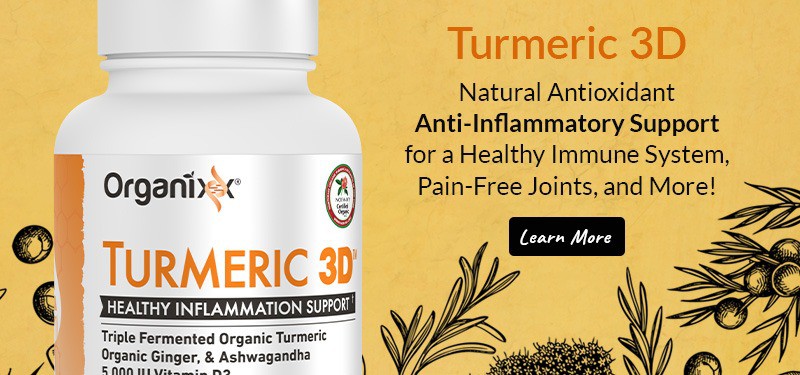
Tulsi or Holy Basil is amongst the most highly revered of the known therapeutic shrubbery for its ability to elevate the mind, heal the body, and uplift the soul. This enchanting herb, also known as Ocimum sanctum, is an important part of the repertoire of India’s traditional system of medicine, known as Ayurveda.
Holy Basil boasts cherished status as one of the world’s most sacred herbs because it possesses what many traditional healers consider to be near-miraculous healing potential − hence why it’s earned esteemed titles including “The Elixir of Life” and “Mother Medicine of Nature.”
In Ayurveda specifically, Tulsi is classified as a “rasayana,” delineating its MVP (most valuable player) status in the realm of adaptogenic herbs. Similarly, in Traditional Chinese Medicine (TCM), Tulsi is regarded as a “Shen tonic,” a designation that suggests it possesses an almost inherently divine essence. A healing gift straight from the heart God, so to speak.
What seems to set Holy Basil apart is the fact that it encapsulates each of the three elements that embody holistic health − mind, body, and soul.
Even in contemporary functional medicine, Holy Basil is recognized as having what some might describe as miracle-esque properties. Its other name, Tulsi, actually translates as “incomparable one,” and the plant is considered to be sacred everywhere that it’s grown.
From calming the mind and relieving stress to boosting immunity and helping to quell inflammation, Tulsi outperforms many other therapeutic herbs. One reason is that it works holistically at the systemic level to normalize and balance the entirety of the human form, as opposed to just one or a few individual parts.
The Physical Healing Power of Holy Basil
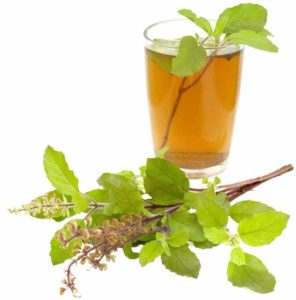 The traditional Indian way to use Holy Basil involves brewing it as a tea or taking it as a tincture to treat colds and influenza. It’s used to help break up mucus and phlegm while cleansing the respiratory tract, lungs, and nasal passages of toxins, and it can even be added to baths for the same purposes.
The traditional Indian way to use Holy Basil involves brewing it as a tea or taking it as a tincture to treat colds and influenza. It’s used to help break up mucus and phlegm while cleansing the respiratory tract, lungs, and nasal passages of toxins, and it can even be added to baths for the same purposes.
Holy Basil taken orally is also helpful in overcoming digestive distress. It’s been shown to not only help improve nutrient absorption and boost mucus production inside the stomach, but also help unwind all that nervous stress that many people carry around with them inside their guts.
Also remarkable is the pronounced restorative effect that Holy Basil has on the central nervous system. Regular use of the herb is said to strengthen nerve tissue and improve brain neurochemistry, which in turn leads to better memory and improved mental clarity. Holy Basil’s nerve-calming properties are likewise beneficial in helping to relieve bodily stress.
Tulsi Helps Protect Against Radiation
With regards to the human genome, Holy Basil also shows radio-protective benefits in that it helps to shield the body against the DNA-damaging effects of ionizing radiation.
Cumulative exposure to radioactive elements from things like mobile phones, wireless routers, radiation and chemotherapy treatments, and other sources can cause prolonged damage to cells, which absorb and store it as inflammation.
Holy Basil is also considered to be a powerful prophylactic (life-extending) herb. Among its many researched benefits in the longevity department are stress reduction, cholesterol modulation, blood sugar balance, and liver protection.
It works even better when combined with other plants and herbs of a similar nature such as chamomile and rose. This concept is what’s known as nutritional or therapeutic synergy, or the combining of multiple substances to produce a more pronounced effect.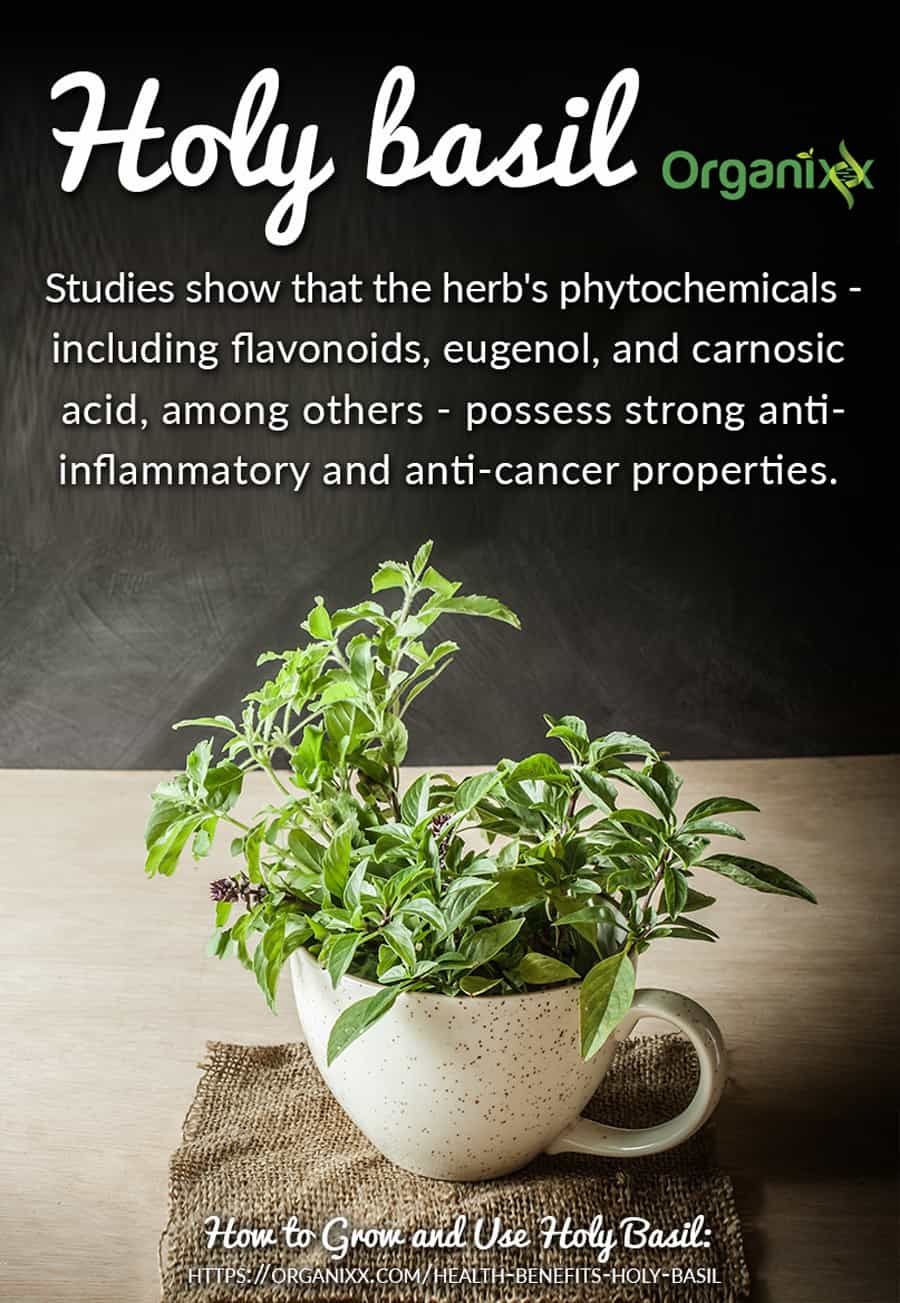
Can Holy Basil Address “Mind-Spirit” Causes of Disease?
As you can probably imagine, anything that helps soothe the body by gently alleviating pain, calming the nerves, and melting away stress as Holy Basil does is sure to have a positive impact on one’s mental state as well. The body and mind are intimately connected, after all, as is the spirit or soul. Holy Basil’s effects on all three are profound.
Recognizing that the herb helps restore the central nervous system and keep it in balance, many believe that Holy Basil also possesses curative properties when it comes to addressing the so-called “Mind-Spirit” causes of disease. This is the unhealthy thought and belief patterns that sometimes manifest as physical ailments.
By helping to essentially restore peace of mind, Holy Basil is traditionally used to get to the root of a Mind-Spirit illness and nip it in the bud in a way that pharmaceuticals and other methods often can’t.
As mentioned above, the Chinese consider Holy Basil to be a Shen tonic with a divine nature. This concept centers around the idea that Holy Basil is a bio-energetic field harmonizer.
This basically means that it helps normalize the various subtle electromagnetic fields throughout our bodies and minds that govern how we function physically. Maintaining this balance is an important part of what it means to be healthy.
How to Grow and Use Holy Basil
 So, how does one use Holy Basil? If you’re all about fresh, you can actually pick the leaves right off the live plant and eat them with your salad or another dish. You can also consume them all by themselves, with a typical serving ranging between 3-15 leaves.
So, how does one use Holy Basil? If you’re all about fresh, you can actually pick the leaves right off the live plant and eat them with your salad or another dish. You can also consume them all by themselves, with a typical serving ranging between 3-15 leaves.
Growing the plant at home is actually quite simple as well, especially if you’re already familiar with how to grow normal basil − make sure the soil is moist, and feel free to expose the plant to either full sun or partial shade.
If tea is more your style, you can derive many of Holy Basil’s healing benefits by steeping between 1-3 bags of the dried herb in water. Some experts recommend heating water to just below a full boil to preserve as many of the plant’s active constituents as possible.
You can also take the fresh leaves and flowering tops of the plant and turn them into tinctures or infused oils by adding the raw plant material to a glass jar and soaking it in either 80-proof vodka or pure vegetable glycerine for four to six weeks, shaking or stirring the mixture regularly. When complete, strain the liquid through an unbleached cheesecloth and use as needed.
To ensure that you’re getting the most potently bioavailable extracts, be sure to choose only wild-harvested, biodynamic, or certified organic varieties sold by companies that source their raw materials in an ethical and responsible way.



